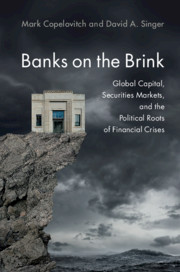Book contents
- Banks on the Brink
- Political Economy of Institutions and Decisions
- Banks on the Brink
- Copyright page
- Dedication
- Contents
- Figures
- Tables
- Preface
- Acknowledgments
- 1 The Politics and Economics of Financial Instability
- 2 Banking Crises, Capital Flows, and Financial Market Structure
- 3 Capital Inflows, Market Structure, and Banking Crises
- 4 O Canada? Unraveling the Mystery of Canadian Bank Stability
- 5 Finanzplatz Deutschland
- 6 Policy Responses
- References
- Index
- Political Economy of Institutions and Decisions
3 - Capital Inflows, Market Structure, and Banking Crises
Empirical Evidence
Published online by Cambridge University Press: 10 February 2020
- Banks on the Brink
- Political Economy of Institutions and Decisions
- Banks on the Brink
- Copyright page
- Dedication
- Contents
- Figures
- Tables
- Preface
- Acknowledgments
- 1 The Politics and Economics of Financial Instability
- 2 Banking Crises, Capital Flows, and Financial Market Structure
- 3 Capital Inflows, Market Structure, and Banking Crises
- 4 O Canada? Unraveling the Mystery of Canadian Bank Stability
- 5 Finanzplatz Deutschland
- 6 Policy Responses
- References
- Index
- Political Economy of Institutions and Decisions
Summary
Thus far in the book, we have described the substantial variation in banking crises, capital inflows, and financial market structure across the industrialized world in the post–Bretton Woods era, and we have argued that the destabilizing impact of capital inflows is conditional on the relative prominence of banks versus non-bank financial markets. When banks compete with well-developed national securities markets to provide financing for businesses, their appetite for risk increases. As we discussed in Chapter 2, securities markets can incentivize even the most traditional commercial banks to take on more risks, even if those risks do not appear to be closely tied to securities markets. Capital inflows amplify this risk and increase the chance of a banking crisis. In contrast, when banks operate alongside relatively underdeveloped securities markets, they maintain their conservative bias and capital inflows are less likely to be destabilizing. Ultimately, it is the combination of foreign capital inflows and domestic financial market structure that tips the balance between banking stability and banking crises.
- Type
- Chapter
- Information
- Banks on the BrinkGlobal Capital, Securities Markets, and the Political Roots of Financial Crises, pp. 43 - 87Publisher: Cambridge University PressPrint publication year: 2020



